Hawkfish are a favorite of aquarists around the world thanks to their size, bold color, and hardy nature. And of all the species that exist out there the flame hawkfish might be the most popular!
Vibrantly crimson, outgoing in personality, and a little comical in appearance, they are excellent additions to both fish-only and reef aquariums. What is the flame hawkfish and how can we care for one?
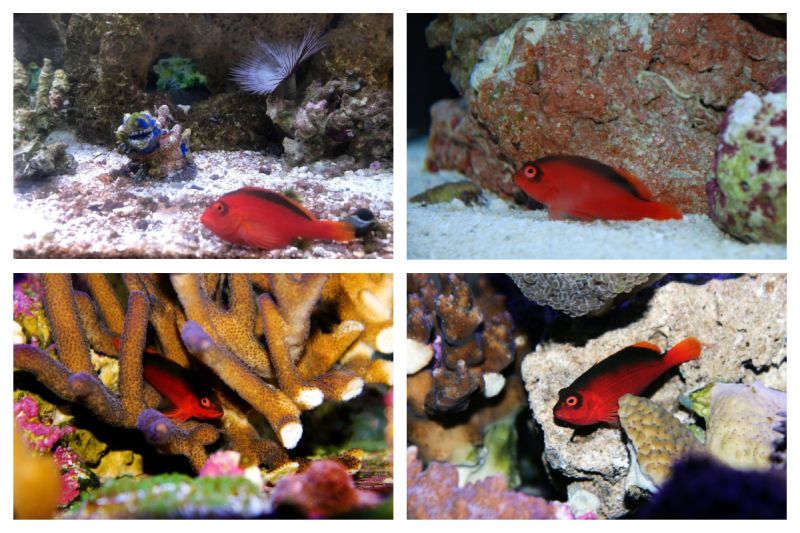
Flame Hawkfish Facts
Unlike most marine fish hawk fish do not have a swim bladder. Nearly every other fish has a swim bladder and uses this organ to maintain neutral buoyancy relative to the surrounding seawater. Instead of floating hawkfish sit on coral and rock outcroppings, waiting for prey to waft or crawl by. When they see something of interest, hawkfish dart over and snap it up before returning to their perch!
There are two main species of hawk fish that you are likely to encounter in pet stores: the Longnosed Hawkfish (Oxycirrhites typus) and the Flame Hawkfish (Neocirrhites armatus). You are very unlikely to confuse the two, however.
As you’d expect, the Long Nosed Fish has a mouth shaped like a protruding beak that it uses to snatch tiny crustaceans and worms from coral crevices. It also has a mottled white and red pattern and a much slimmer profile. Meanwhile the Flame Hawkfish is a solid red animal with a black back; plus it is more traditionally fish-shaped!
Both species of Hawkfish can be a little more demanding to keep than most fish. They are prone to being territorial and are large enough to require more spacious tanks than a beginner may want to provide. However once fully acclimated they are intriguing reef and fish only community tank residents!
These fish are found throughout the Pacific Ocean, from Hawaii all the way to Australia and island reef archipelagoes like Tonga and Fiji!
Scientific Name: Neocirrhites armatus
Origin: Southwestern Pacific
Length: 4 to 5 inches
Aquarium Size: 40 gallons
Temperament: Semi-Aggressive
Ease of Care: Intermediate
Keeping the Flame Hawkfish
While Flame Hawkfish are fairly hardy in captivity, keeping them with more peaceful tank mates can be a little complicated. They are also sometimes unwilling to easily adapt to dead and frozen foods.
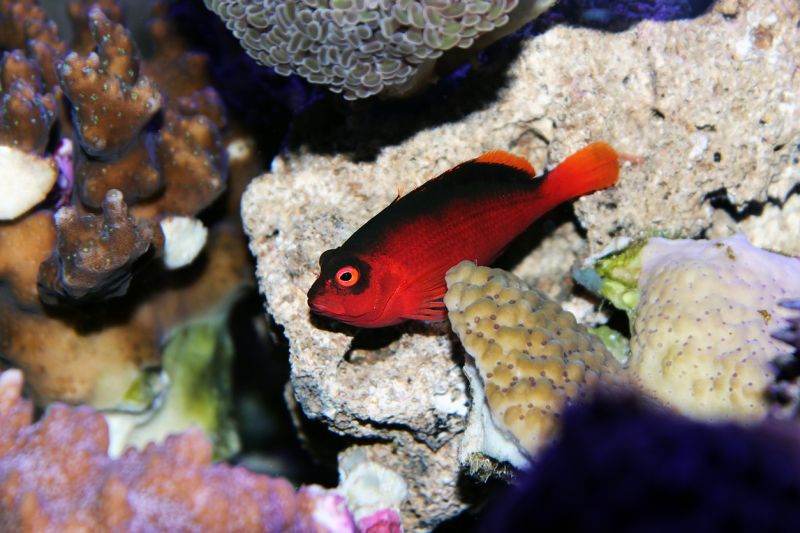
Flame Hawk Fish Aquarium Size
Flame hawkfish are not too large but as solidly medium-sized fish you’ll need an upgrade from the 10 to 20-gallon aquariums that beginning aquarists prefer.
Flame hawk fish should be kept in aquariums no smaller than 40 gallons as fully grown adults.
There are two reasons why you need to provide a spacious tank when keeping flame hawkfish. The first is that these are not small fish: they grow up to 5 inches long and are deep-bodied carnivores. This means that their bioload is pretty substantial and they create a lot of ammonia and other waste products. So the more water volume you have to dilute these agents, the better!
And the second reason is that red hawkfish are a little on the more aggressive side compared to other saltwater community fish. They won’t go out of their way to harass their tank mates when given a territory to call their own.
A few coral perches will keep your hawkfish focused on defending their chosen spot. It is also smart to offer a few since you can’t know which location your hawk fish will prefer.
Also, if the aquarium is too small or crowded your other fish may constantly blunder into the immediate area around its perch. The flame hawkfish may then start to nip at any fish that gets too close for comfort, stressing its tank mates.
Water Conditions for Flame Hawkfish
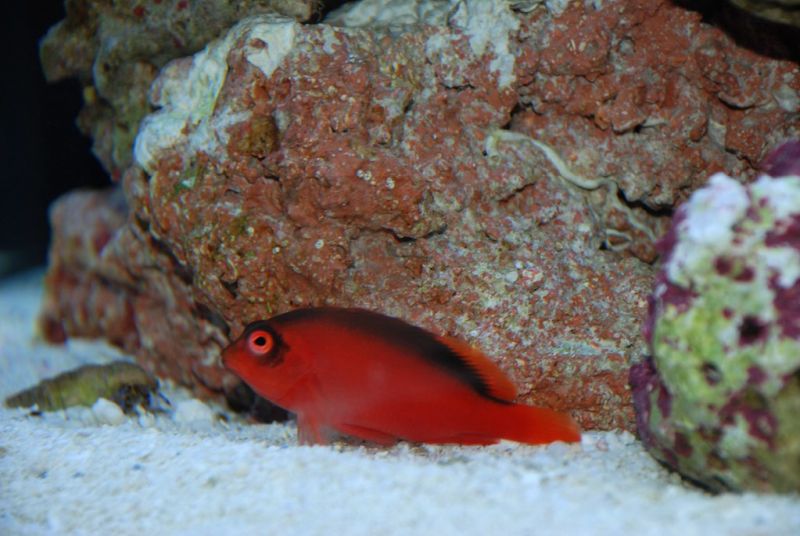
Being entirely carnivorous and thick-bodied, the blood-red hawkfish is a big producer of ammonia and other waste products. And since these fish are all wild-caught from the Pacific Ocean you will want to keep ammonia, nitrite, and nitrate as low as possible.
Flame hawkfish aren’t as fragile as some Tangs and Angelfish but they do require high-quality water. Only keep them in fully mature tanks that have finished undergoing the biological cycling process!
Like most marine fish you will want to aim for specific gravity of around 1.020 to 1.025; higher if you are keeping your flame hawkfish in a reef aquarium. Incidentally, these fish are considered reef safe since they won’t disturb large polyp and small polyp stony corals. Nor do they pick at soft corals. The worst they will do is perch nearby or on both living and dead corals but only in order to survey their domain!
Their temperatures should remain between 73 and 78℉ and the pH should stay between 8.1 and 8.4. Fortunately, with the crushed coral aragonite substrate common to all marine aquariums these conditions are easy to maintain. The water will remain buffered towards the ideal hardness this way.
Trace minerals like calcium, strontium, magnesium, and other elements are important for fish as they are for corals. But so long as you are performing water changes using a marine aquarium sea salt blend, you have nothing to worry about.
Since these saltwater blends are formed from evaporated seawater they contain every major and trace element flame hawkfish need for survival. And they are replenished with each water change you perform!
A little bit of current also goes a long way towards keeping the flame hawkfish happy and healthy. A powerhead or filter outflow that provides a steady, gentle stream of warm, well-oxygenated water is perfect for them. Especially if you can direct it right over their favored perch without the flow being too strong!
Red Hawkfish Saltwater Tank Mates
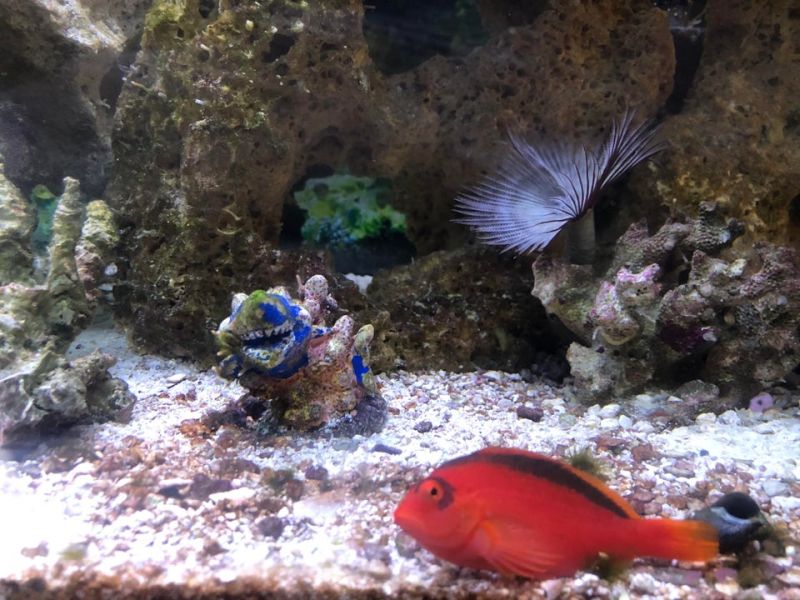
Choosing tank mates for the flame hawkfish needs to be done with a little care. As I said before these fish are a little territorial and intolerant of intruders. Any fish that also enjoys exploring the substrate should be given space to find hiding places of their own.
Cavity-dwelling fish that may fight with a red flame fish in an aquarium that is too small include Royal Grammas, Engineer Gobies, Marine Bettas, and Moray Eels.
A 40-gallon predator tank (preferably much larger) is a good setup for keeping red hawkfish alongside other semi-aggressive fish like Lionfish, Triggerfish, and Groupers! Semi-aggressive fish that patrol the water column are also a good match, including most Damselfish, Tangs and Surgeonfish, Dottybacks, and Angelfish, both Pygmy and larger species!
More peaceful fish can also work, such as Clownfish. But just make certain that they have enough space to avoid the perch claimed by your red hawkfish or hawk-nosed fish!
Unfortunately, flame hawkfish do not get along easily with either their own kind or other species of hawkfish, including the Longnosed Hawkfish. Not unless you have an aquarium larger than 75 gallons, where each hawk fish can have its own perch at opposite ends of the tank. These fish do form social groups in nature but the endless space offered ensures that they can work out their aggressive tendencies.
The flame hawk is mostly invertebrate safe so long as you choose their tank mates thoughtfully. Any small shrimp are going to be eaten. However many aquarists report that large shrimp-like Banded Coral Shrimp, Pistol Shrimp, and Blood Red Fire Shrimp can live alongside a flame hawkfish. Especially if the hawkfish is raised alongside its tank mate when still small.
Snails, Starfish, and other less tasty invertebrates are going to be ignored. Except for Feather Duster Worms, which are definitely on the menu. The long-nosed fish is especially good at plucking the meaty body of these worms out from their protective tubes.
That said, all hawkfish are mostly to entirely reef-safe. They rarely pick at and don’t actually eat sea anemones, corals – including soft corals, sponges, tridacna giant clams, or other sessile (non-moving) invertebrates!
Good Flame Hawk Fish Tank Mates:
- Lionfish, Groupers, Triggerfish, and other Predatory Fish
- Damselfish, Angelfish, Tangs, Dottybacks, and other Semi-Aggressive Fish
- Large Shrimp, Crabs, Snails, Starfish, and other Motile Invertebrates
- Sea Anemones, LPS and SPS Corals, Soft Corals, Giant Clams, and other Sessile Invertebrates
Poor Flame Hawk Fish Tank Mates:
- Clownfish and other Peaceful Fish (with caution)
- Engineer Gobies, Moray Eels, Royal Grammas, Mandarin Gobies, and other substrate dwellers
- Small Shrimp and Worms
- Other Hawkfish
Feeding Blood Red Hawkfish
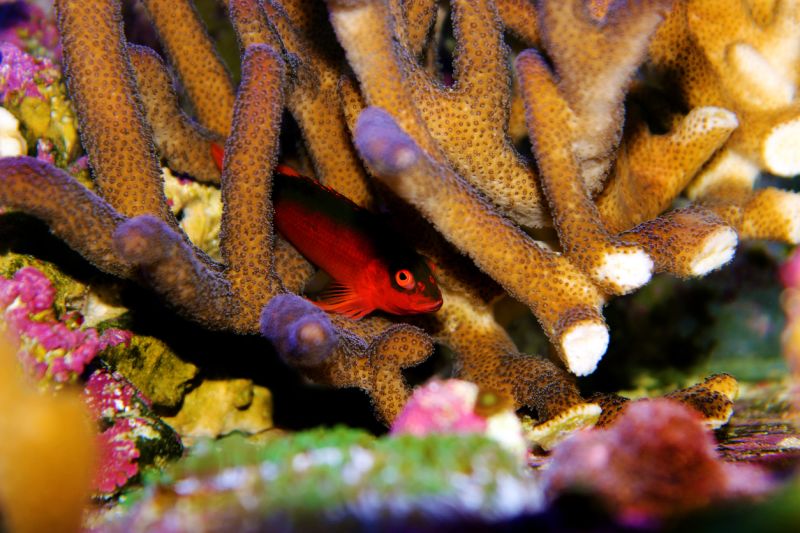
Feeding the flame hawk fish can sometimes be a challenge at first once these fish are caught from the wild and imported into captive care. These fish are predators that have excellent eyesight. When a hawkfish sits on its perch it is doing the same thing as an aerial flying hawk is doing: scanning its surroundings for prey!
When a red hawkfish sees something moving, it locks on with its good vision and swoops over to snatch up the worm or crustacean. Small fish, shrimp, baby crabs, and other items are what they most commonly eat in nature.
Since they are predatory and strongly focused on movement it can be really difficult to get a hawkfish to eat dead food that isn’t moving. Your best bet to get a fussy flame hawkfish to eat is to start off with live food. Live brine shrimp, blood worms, and tubifex worms will help get some weight on your fish as it settles into its new home.
And once your new flame hawk fish is used to eating you can start mixing in frozen foods – or even protein-rich pellets and flames. Eventually, your hawkfish will learn to eat anything that is on offer, even dead food!
Another trick to feeding a picky flame hawkfish is to enhance the smell of your prepared or frozen food. Flavor enhancers using garlic not only bolster the immune system of your fish – they also make food more palatable by boosting the smell and taste!
Breeding Red Hawk Fish
Unfortunately, breeding the red hawkfish is almost never achieved in captivity. The fish are too territorial and aggressive for it to be easily achieved. Providing enough space for hawk fish to establish sexes and territories is the main issue. You would need an aquarium hundreds of gallons in volume to have a chance of spawning these beautiful fish.
Sexing Flame Hawkfish
Unfortunately, these fish are complicated to both sex and breed. If you are keeping your red hawkfish alone it is almost certainly a female. Like many marine fish they are protogynous sequential hermaphrodites. This means that all hawk fish are born as females at first! It is only when a fish becomes dominant in a group setting that it transforms into a male.
So without the stimulus of other hawkfish around to compete with, your fish will remain in its female stage. But by keeping them together you will need a very large tank since they will fight it out to establish dominance and a pecking order among the group.
Frequently Asked Questions about the Flame Hawkfish
These hawk fish are considered semi-aggressive fish. Flame hawkfish usually keep their aggression centered around their perch. Any fish that gets too close may be chased off or nipped. But most fish are otherwise ignored.
All hawkfish are predatory, however, and they have excellent eyesight. Tiny tank mates are potential meals for a hungry hawk fish!
Flame hawkfish are reef safe: with caution. They will eat small shrimp, feather duster worms, and may irritate corals into closing up with their perching habits. But they don’t usually pick at or eat hard corals, soft corals, or sea anemones.
Flame hawkfish are solidly medium-sized aquarium fish. They typically reach between 4 and 5 inches long at full maturity!
Flame hawkfish are typical $40 to $70 for a small to medium-sized fish!

